High-frequency trading (HFT) has transformed financial markets by executing trades in microseconds, leveraging advanced algorithms, and providing liquidity across global exchanges. This article highlights the top 10 HFT firms shaping the industry, each excelling in speed, infrastructure, and market presence. Here’s a quick snapshot:
- Citadel Securities: A leader in real-time analytics, pricing, and risk management across 50+ markets.
- Virtu Financial: Operates in 235+ venues globally, excelling in multi-asset trading and dark pool aggregation.
- Jane Street Group: Known for ETF and fixed income expertise, supported by a strong academic-driven culture.
- Hudson River Trading: Focuses on low-latency trading and systematic risk management.
- Jump Trading: Excels in statistical arbitrage and cryptocurrency trading.
- Tower Research Capital: Empowers independent teams for diverse strategies across global markets.
- Two Sigma Investments: Utilizes massive data and computational power for liquidity and intraday strategies.
- Optiver: A major market maker in options and futures, with a focus on speed and precision.
- IMC Trading: Offers liquidity in equities, bonds, commodities, and cryptocurrencies across 90+ venues.
- Flow Traders: Specializes in Exchange Traded Products (ETPs) with advanced algorithms and global coverage.
These firms dominate the HFT space by combining advanced systems, global reach, and expertise in various asset classes. They continue to innovate while navigating evolving markets and regulations.
Top Quant Funds, High Frequency Trading Firms (HFT) , and Algorithmic Algo Firms
1. Citadel Securities
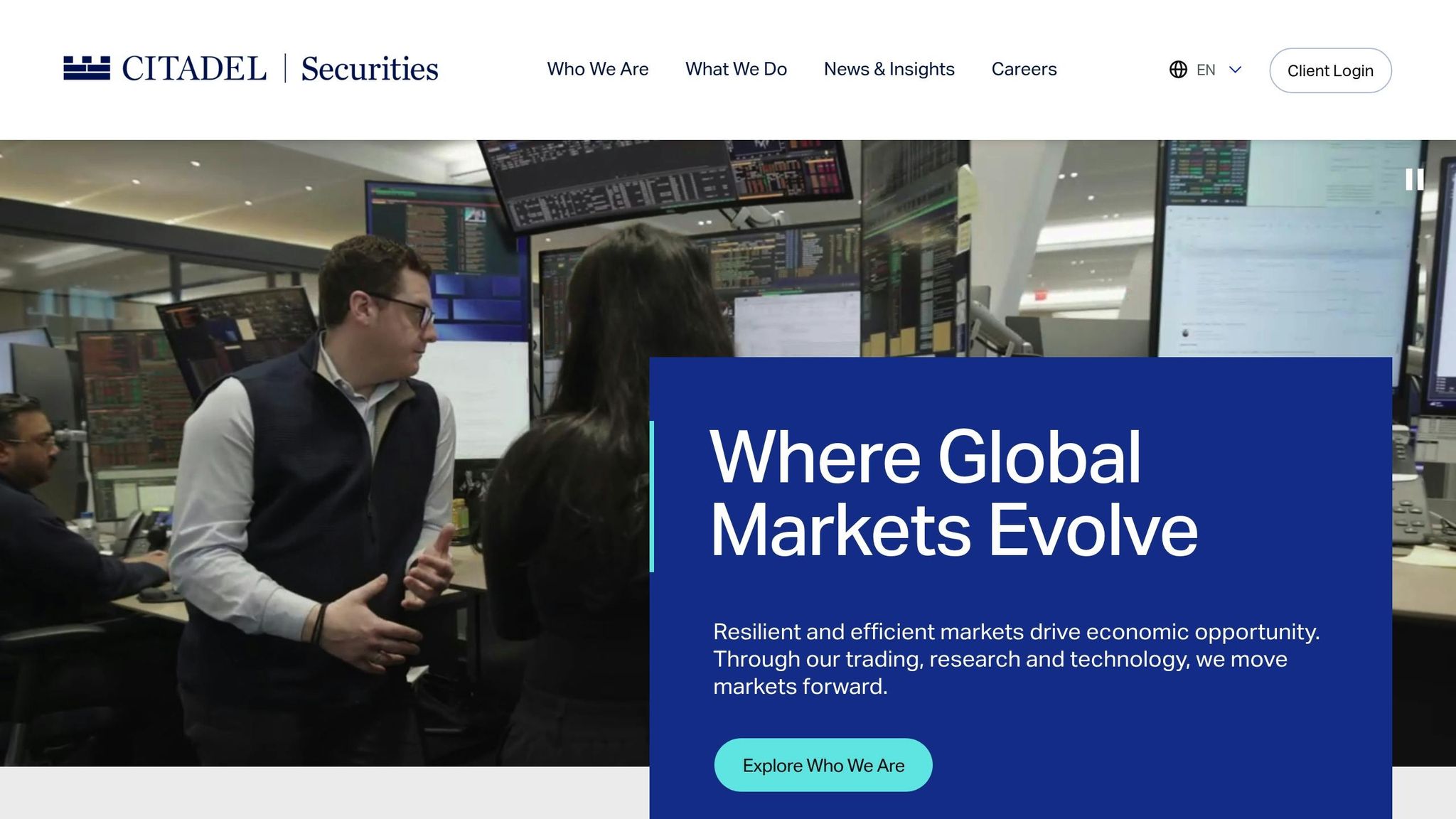
Citadel Securities is a powerhouse in the world of high-frequency trading (HFT). Founded by Ken Griffin, the firm runs a sophisticated real-time data processing system designed to keep trading spreads exceptionally tight.
The firm’s analytics engine prices hundreds of thousands of securities in real time, spanning over 50 markets and 150 trading venues [1][3].
Citadel Securities relies on cutting-edge technologies like distributed computing, natural language processing, and machine learning to trade across various asset classes [1][3]. Their advanced models constantly evaluate market conditions, making dynamic adjustments to portfolios as needed [3].
Ken Griffin highlights the firm’s focus on technology, saying:
"We really think about the technological capabilities that we bring to the table as being systems in our fundamental businesses that drive better decision-making." [3]
A key factor in their success lies in their dedication to continuously upgrading their infrastructure. Josh Woods, the firm’s CTO, emphasizes this approach:
"This is a way to, over time, keep your agility. If you don’t do these things, your technology stack eventually gets more rigid than you’d like, and then when you need to stretch, you’re unable to." [3]
Their risk management framework is equally impressive, leveraging advanced analytics to optimize trade execution and manage exposure with precision [2]. This system has also enabled Citadel Securities to expand into Eurozone bond markets [4].
| Technology Component | Function | Market Impact |
|---|---|---|
| Real-time Analytics | Processes live data from 50+ markets | Facilitates instant price discovery globally |
| Predictive Models | Prices hundreds of thousands of securities | Maintains tight spreads and ensures market liquidity |
| Risk Management Systems | Monitors and adjusts trading positions | Enhances precision during volatile market conditions |
Citadel Securities takes a collaborative approach to innovation, with investment teams and engineering groups working closely to develop tools and models tailored to specific market opportunities [3].
2. Virtu Financial

Virtu Financial stands out in the high-frequency trading (HFT) world by combining advanced technology with a global reach. With operations in over 235 venues across 37 countries, Virtu is a major player in electronic market making, offering liquidity for more than 25,000 securities worldwide [5]. What sets Virtu apart is its multi-asset approach, covering equities, foreign exchange, fixed income, futures, options, and even digital assets. This broad scope allows the firm to blend market expertise with cutting-edge execution technology.
A key part of Virtu’s success lies in its execution services. The firm employs a global algorithm suite designed for speed and adaptability, supporting strategies for single stocks, portfolios, and pairs. Its event-driven Smart Order Router is tailored to find the best prices across both lit and dark venues [6]. Virtu also provides a Dark Pool Aggregation service, granting access to hidden liquidity sources like POSIT, alternative trading systems, and exchange dark order types. One standout tool is the Best Market Server (BMS), which evaluates orders for inter-listed securities in U.S. and Canadian markets, factoring in real-time foreign exchange rates to secure the best prices and liquidity [6].
| Service Category | Key Features | Market Coverage |
|---|---|---|
| Market Making | Liquidity for 25,000+ securities | 235+ venues in 37 countries |
| Algorithm Suite | Single-stock, portfolio, and pairs strategies | Global multi-asset coverage |
| Dark Pool Aggregation | Access to hidden liquidity with minimal info leakage | Efficient order allocation |
Virtu is also a leader in options market making, handling both single names and index complexes. In the digital asset space, the firm has made strides in Bitcoin market making, supported by Spot Bitcoin ETFs [7]. Additionally, Virtu is growing its fixed income operations by onboarding new clients and expanding its product offerings. Its integrated approach – combining liquidity, workflow, execution, and analytics – enables institutional investors to act quickly and confidently. Backed by skilled teams and advanced routing technology, Virtu ensures high-quality execution while reducing market impact [6].
3. Jane Street Group
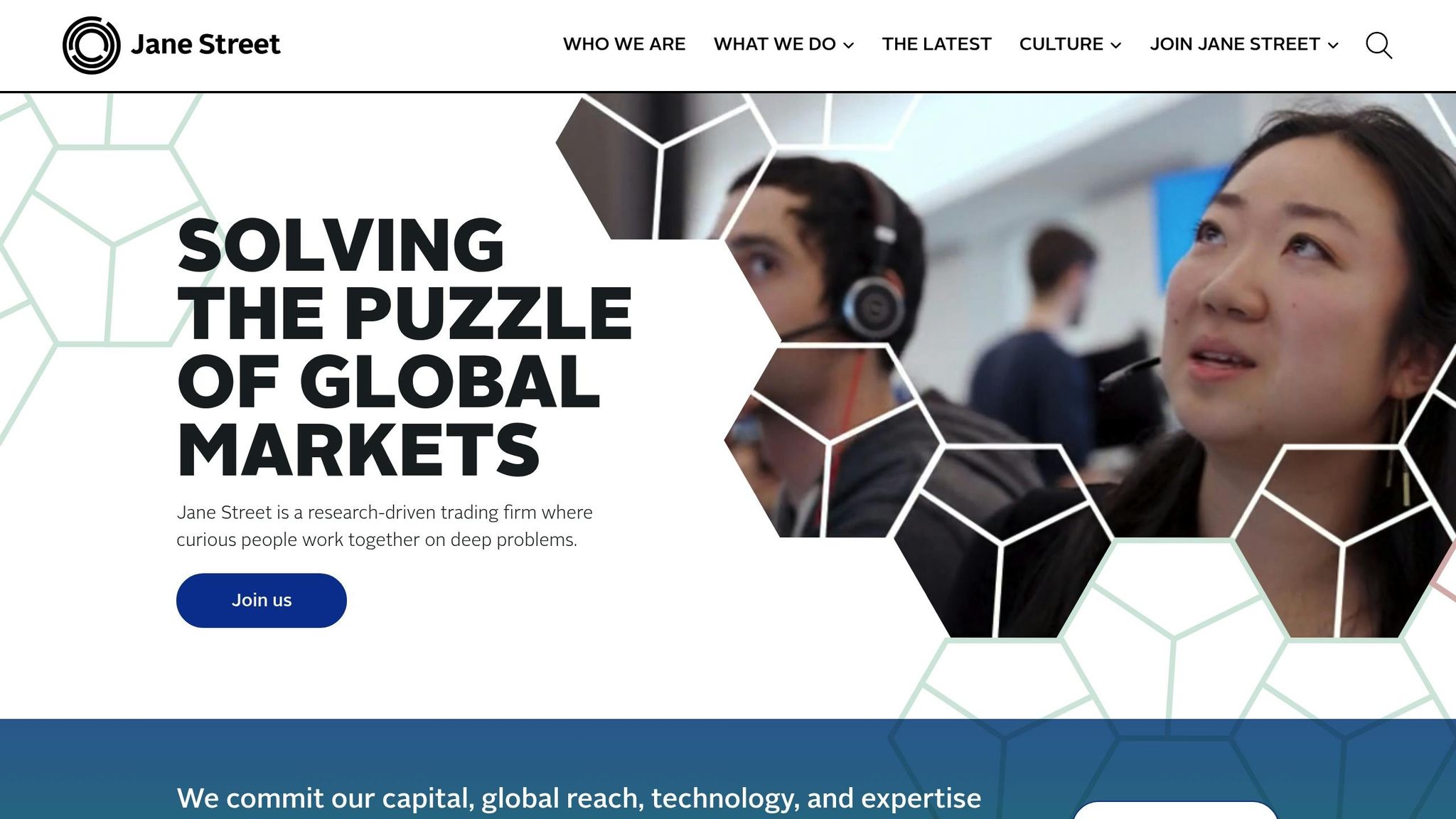
Jane Street Group has built a strong reputation through its use of advanced models and proprietary technology. Established in 2000, this proprietary trading firm operates as both a market maker and a liquidity provider across various asset classes. It is particularly well-known for its expertise in exchange-traded funds (ETFs) and fixed income securities. By combining in-depth quantitative research with lightning-fast execution, Jane Street has positioned itself as a key player in the world of electronic trading.
The firm thrives on an academic-driven culture that prioritizes continuous learning and innovation. It actively recruits from top-tier universities, seeking graduates with solid foundations in mathematics, computer science, and physics. This highly skilled talent pool enables Jane Street to create proprietary trading algorithms that can swiftly adapt to changing markets while maintaining consistent profitability across different conditions.
A major factor in Jane Street’s success is its use of co-located data centers, which reduce latency to a minimum. Their trading systems handle millions of price quotes and execute thousands of trades every second, with response times measured in microseconds. The firm’s custom programming language, OCaml, plays a crucial role by allowing for the rapid development and deployment of trading strategies, all while ensuring the reliability necessary for high-stakes operations.
With offices in major financial hubs like New York, London, Hong Kong, and Amsterdam, Jane Street operates on a global scale. Its international presence ensures liquidity around the clock and allows the firm to take advantage of arbitrage opportunities across different time zones and regulatory landscapes. In Europe, Jane Street excels in government bond trading, while in Asia, it focuses heavily on equity derivatives and currency markets.
| Trading Focus | Market Position | Key Strengths |
|---|---|---|
| ETF Market Making | Leading liquidity provider | Advanced pricing models and risk management |
| Fixed Income | Major player in government bonds | Cross-market arbitrage capabilities |
| Equity Derivatives | Significant market share | Rapid adaptation to volatility changes |
Jane Street’s risk management approach emphasizes market-neutral strategies, capturing fleeting price discrepancies without taking major directional risks. This method has allowed the firm to remain profitable even during turbulent periods, such as the March 2020 market crash and the 2022 bond market disruptions.
The firm’s market-making operations go beyond traditional securities, including complex instruments like options and structured products. Its algorithms continuously quote bid and ask prices for thousands of securities, adjusting in real-time based on market conditions, inventory, and risk limits. This constant activity not only helps narrow bid-ask spreads but also enhances market efficiency for both institutional and retail investors.
4. Hudson River Trading
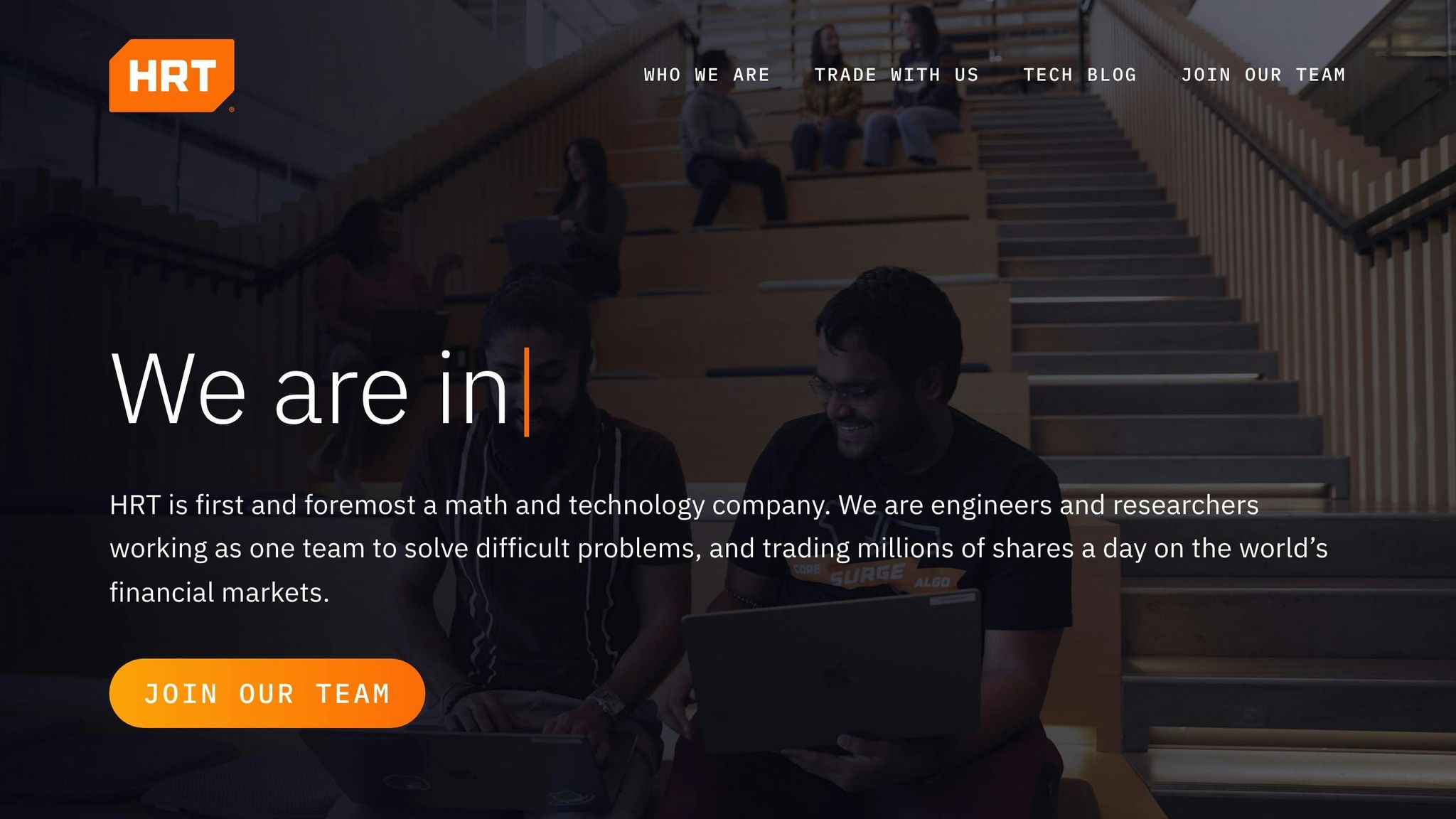
Hudson River Trading (HRT) specializes in high-frequency trading, using advanced algorithms and co-location to handle market-making and proprietary trades across various asset classes with ultra-low latency. By relying on custom-built trading systems, dedicated data centers, and co-location services, HRT ensures trades are executed with remarkable speed.
The firm is constantly improving its trading models and operates from key financial hubs around the world, enabling it to seize opportunities in both traditional and digital asset markets. With a strong focus on systematic risk management and cutting-edge technology, HRT has carved out a prominent role in the highly competitive world of high-frequency trading.
HRT, like other leaders in the field, continues to push technological boundaries, setting the pace for the rapidly evolving HFT industry.
5. Jump Trading
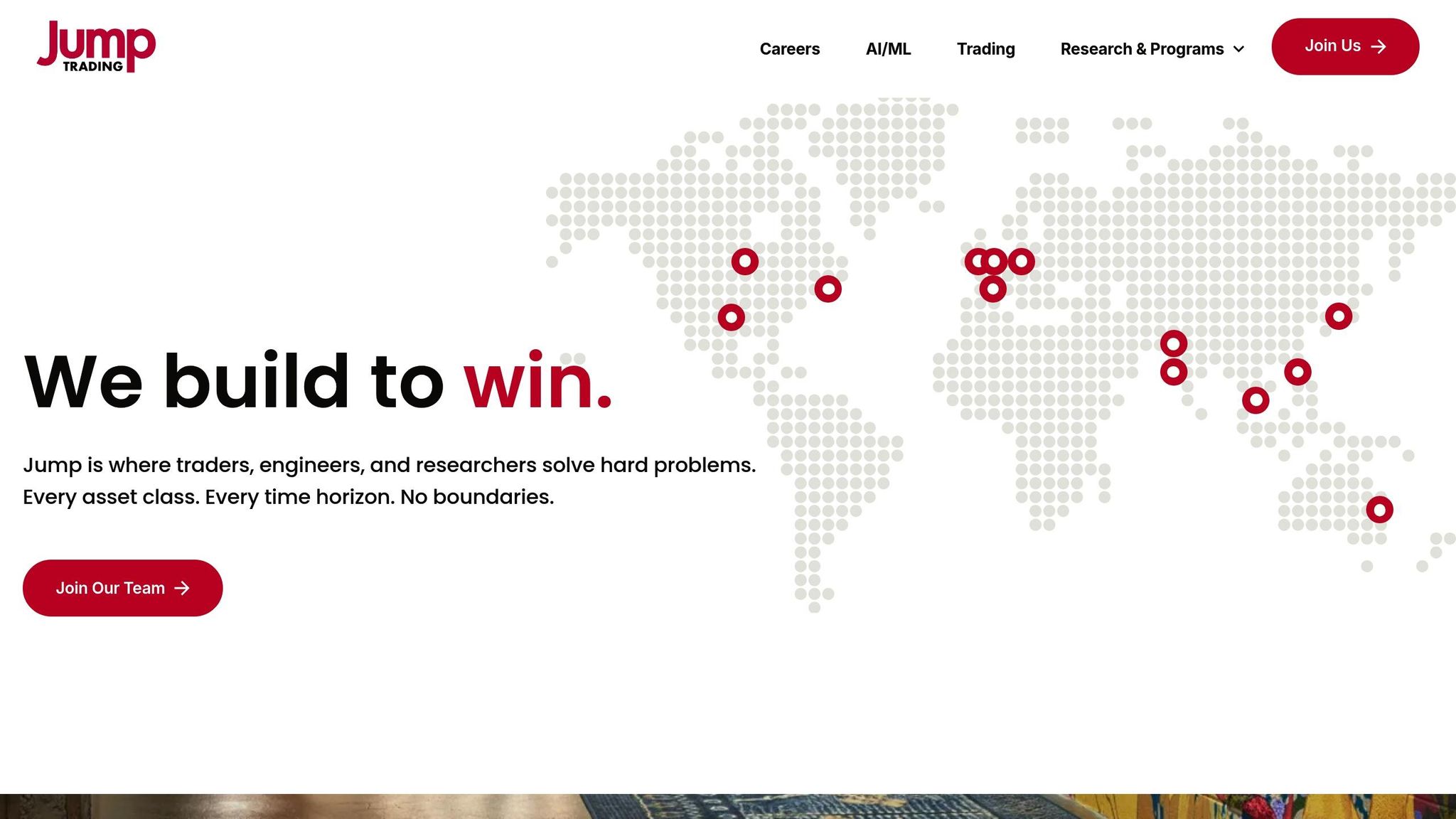
Jump Trading is a proprietary trading firm known for using cutting-edge algorithms and technology to execute high-frequency trades across various asset classes. Headquartered in Chicago, the firm has earned a strong reputation for its focus on quantitative research and systematic trading strategies, which are designed to exploit market inefficiencies in mere microseconds.
At the core of Jump Trading’s approach is statistical arbitrage and market making. Their algorithms analyze price movements and execute trades based on mathematical models, seizing opportunities that exist for only fractions of a second before competitors can react. The firm’s systems are designed to process vast amounts of market data at lightning speed, identifying and acting on these fleeting chances for profit.
To support this approach, Jump Trading invests heavily in a sophisticated technology infrastructure. This includes custom-built hardware and software, specialized network equipment, and strategically placed co-location facilities near major exchanges. These tools allow their systems to operate with microsecond precision, capturing arbitrage opportunities as they arise.
With a global reach, Jump Trading operates offices in Chicago, New York, London, and Singapore, enabling them to trade around the clock. Their presence in multiple financial hubs allows them to capitalize on price discrepancies across global exchanges and participate in various markets, including equities, futures, options, and foreign exchange.
The firm also plays a key role in market making, especially in equity options and ETF markets. By quoting both bid and ask prices, Jump Trading not only generates profits from the spread but also contributes to narrowing price gaps and improving overall market efficiency.
Risk management is another cornerstone of Jump Trading’s operations. The firm employs advanced monitoring systems to track positions and adjust exposure levels in real time based on market conditions. These systems are designed to respond within milliseconds, halting trades or reducing positions when risk thresholds are reached.
Jump Trading has also made its mark in the cryptocurrency markets, leveraging its expertise in high-frequency trading to navigate the challenges of a 24/7, highly volatile trading environment. Despite the unique demands of crypto markets, the firm maintains the rigorous risk controls that are central to its traditional trading operations.
6. Tower Research Capital
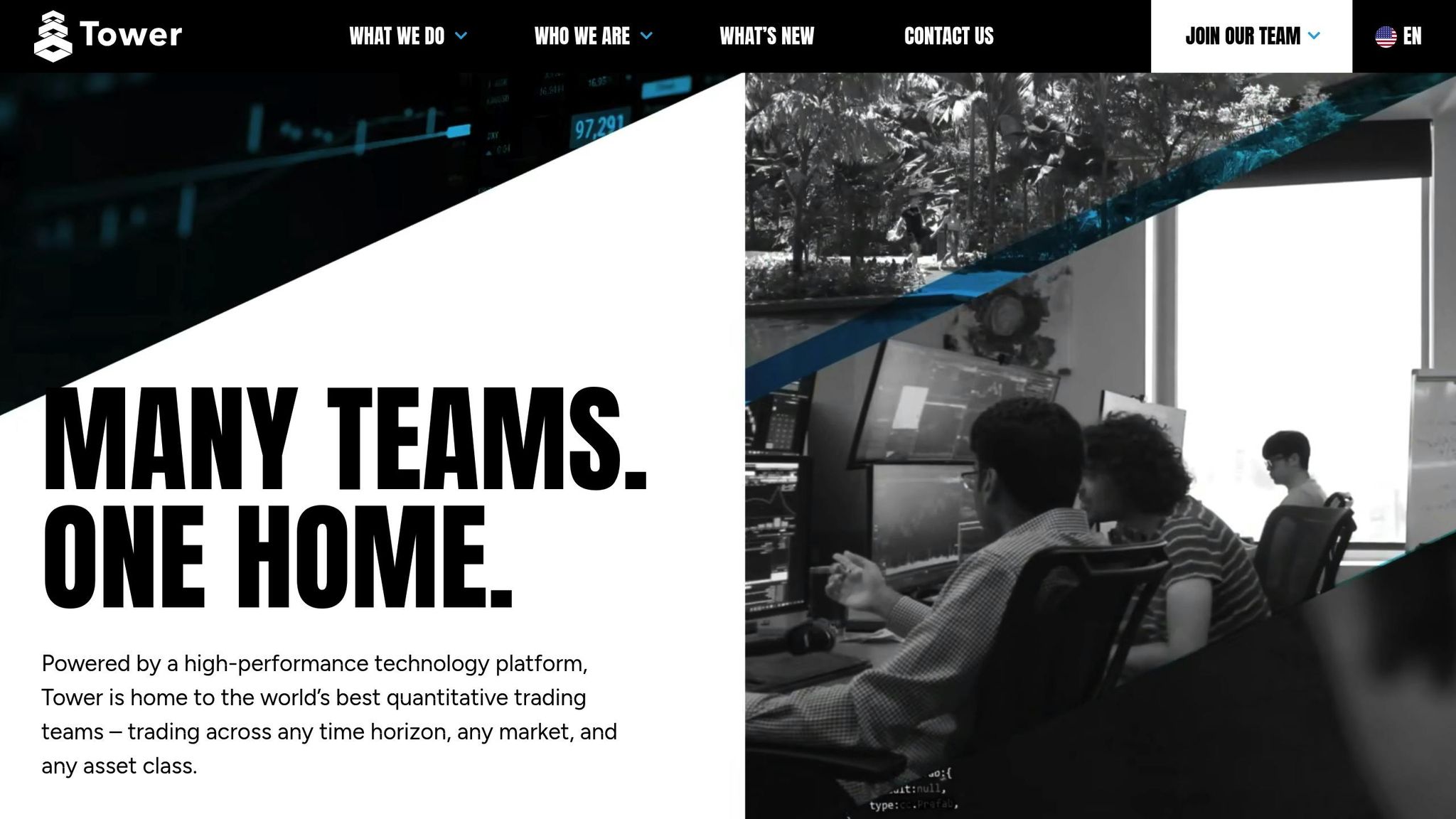
Tower Research Capital has carved out a niche in high-frequency trading by empowering independent quantitative teams to craft strategies across a broad range of markets. These include equities, options, futures, foreign exchange, cryptocurrency, and precious metals. At the heart of their operation is ultra-low latency technology, which ensures speed and precision in trading.
With 11 offices spread across key financial hubs and connections to over 150 trading venues, Tower operates on a truly global scale. This extensive network allows its trading teams to explore and implement strategies in diverse markets, staying ahead in the competitive trading landscape.
In addition to its diverse strategies, Tower is also active in market making, highlighting its focus on tapping into emerging markets and maintaining a dynamic presence in the financial world.
7. Two Sigma Investments
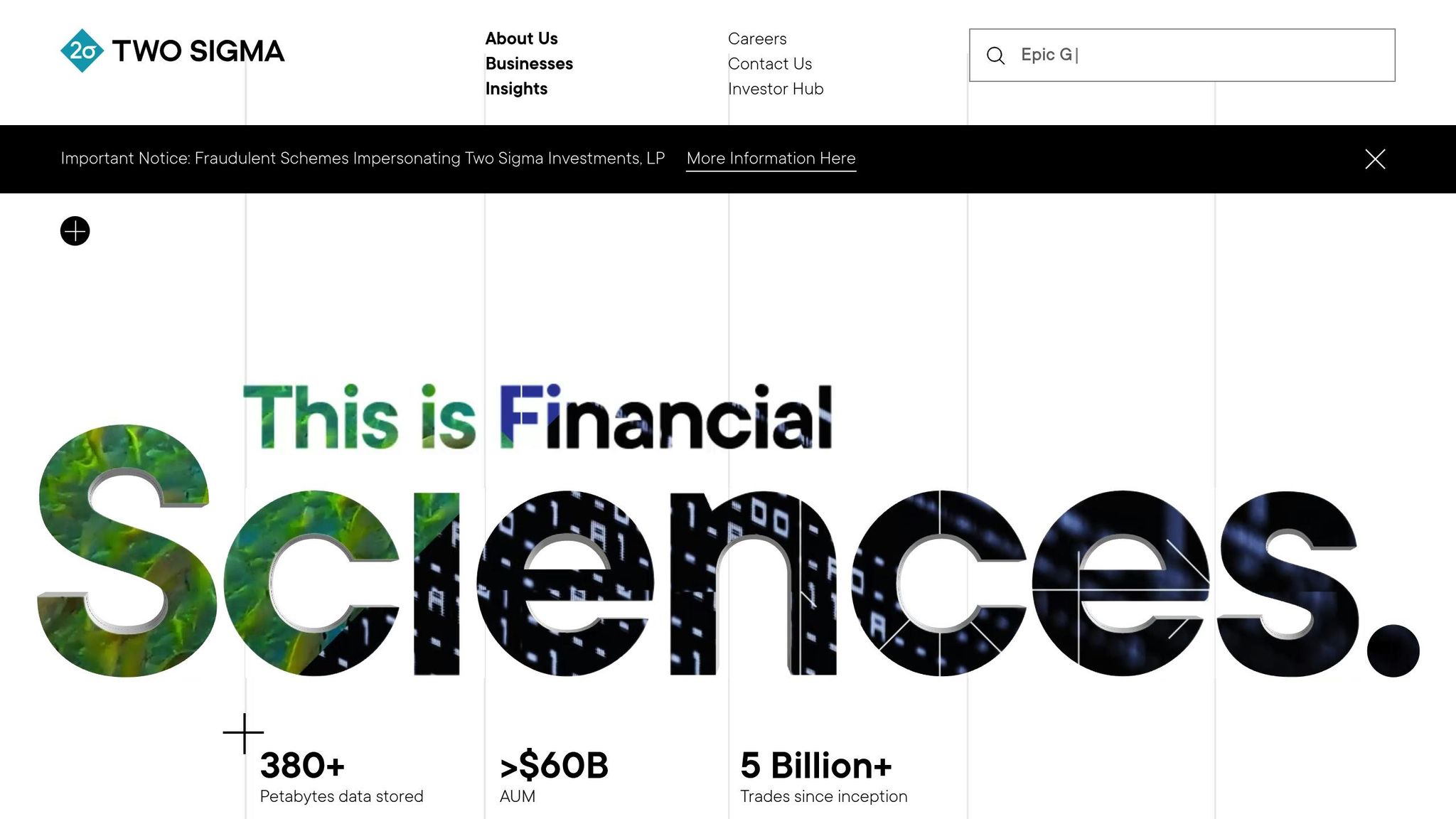
Two Sigma Investments has carved out a niche in high-frequency trading with a methodical, data-focused strategy. Through its Two Sigma Securities platform, the firm uses cutting-edge technology and quantitative analysis to provide liquidity across global markets.
The platform handles an impressive trading volume, executing over 300 million shares daily[9]. This level of activity is powered by what the firm describes as "ultra-low latency systems", which are designed to support both market-making and intraday alpha strategies[8].
"Pushing the frontier in systematic trading to make markets more efficient" – Two Sigma Securities [8]
What sets Two Sigma apart is its computational muscle. It manages over 380 petabytes of data gathered from more than 10,000 sources[9][11]. Its computing power is comparable to some of the most advanced supercomputers in the world. This infrastructure enables the firm to run over 48,000 simulations daily for investment management and more than 100,000 simulations on market data to refine its models[11].
The firm’s scientific approach is evident in its team composition. Out of 1,700 employees, more than 250 hold PhDs, and nearly two-thirds work in research and development. This focus on science and innovation is a key part of the company’s philosophy:
"At our core, we bring a scientific approach to systematic trading and risk management to make markets more efficient" – Two Sigma Securities [8]
Two Sigma credits much of its success to a company culture that values independent thinking, teamwork, and a relentless drive for improvement[8]. By combining advanced systems with a culture of innovation, Two Sigma Securities has secured its place as one of the leading players in high-frequency trading[10].
8. Optiver
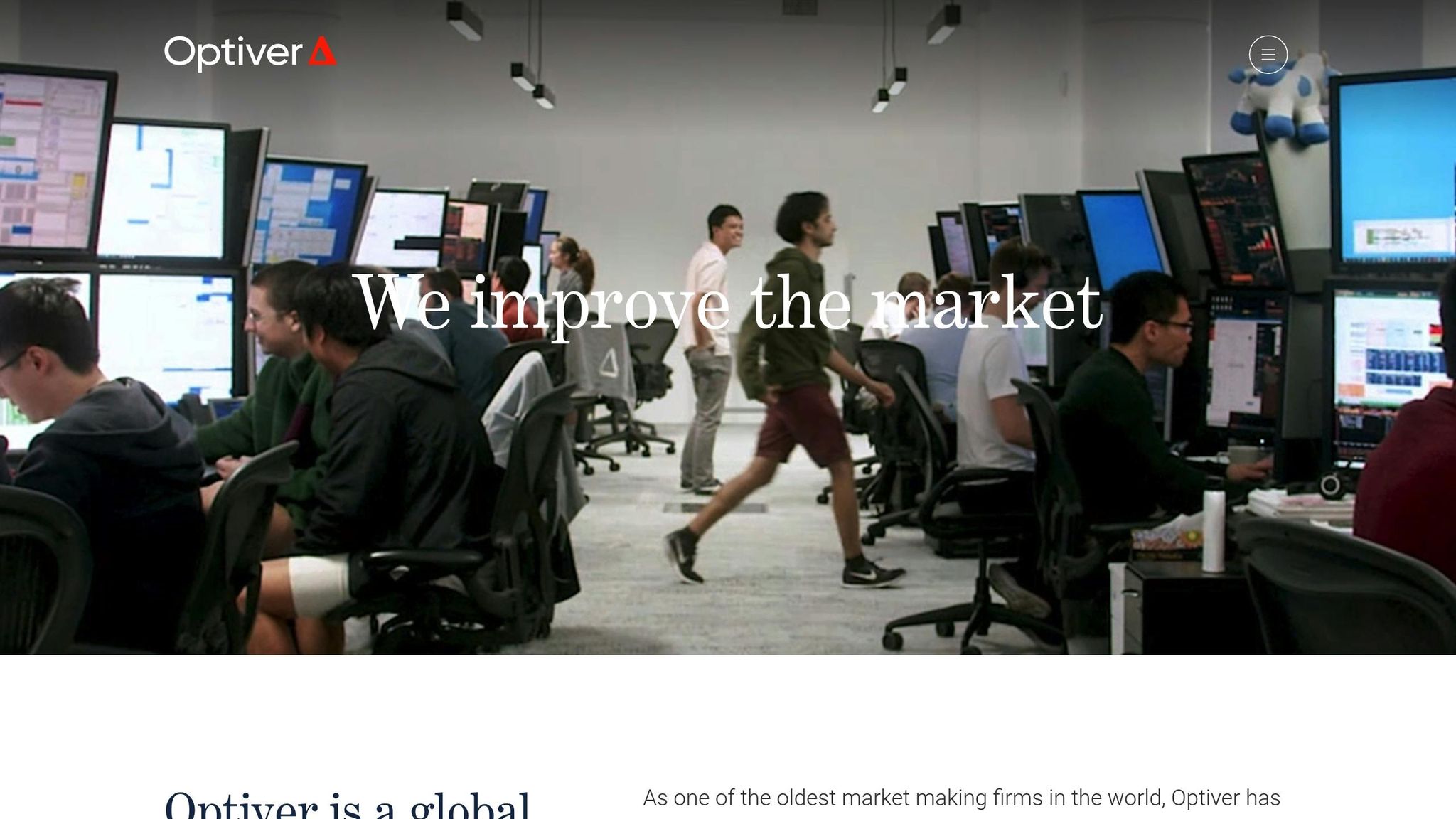
Optiver has cemented itself as a prominent global market maker, known for its speed, precision, and cutting-edge technology. Established in Amsterdam in 1986, the company has grown into a major player, providing liquidity across a wide range of asset classes and regions. Its technological expertise plays a central role in maintaining its strong market presence and efficient trading operations.
The firm specializes in electronic market making, trading various instruments such as equities, ETFs, bonds, options, and futures. Optiver’s reach extends across major exchanges worldwide, including the NYSE, NASDAQ, Eurex, and ASX, positioning it as a global leader in high-frequency trading (HFT).
What sets Optiver apart is its significant investment in low-latency infrastructure. In the world of HFT, where every millisecond counts, the company’s focus on speed and precision enables it to capitalize on fleeting opportunities. This advanced technology allows Optiver to provide tight bid-ask spreads and maintain liquidity, even during volatile market conditions.
Optiver processes billions of dollars in daily trading volume, showcasing its influence in global markets. In the options market, specifically, the firm handles a notable share of the total volume on major exchanges, further underscoring its dominance.
With offices in financial hubs like Amsterdam, Chicago, Sydney, Taipei, and Shanghai, Optiver has a global footprint. Each location plays a strategic role in its operations. For instance, the Chicago office focuses on US equity options and ETF market making, while the Amsterdam headquarters oversees European activities.
Risk management is another area where Optiver excels. The firm employs sophisticated real-time systems capable of adjusting or halting positions within milliseconds during unexpected market fluctuations. This agility is critical in HFT, where success often hinges on split-second decisions. Such robust systems have enabled Optiver to remain profitable, even during periods of intense market turmoil.
Optiver’s hiring strategy reflects its emphasis on technical expertise. The company actively recruits mathematicians, physicists, and computer scientists from leading universities around the world. Its rigorous recruitment process includes challenging mathematical problems and coding tests designed to identify candidates who can thrive in the fast-paced world of HFT.
The firm’s technological infrastructure is built to minimize latency. By leveraging co-location services at major exchanges, Optiver ensures that orders are executed with minimal delay. Additionally, it maintains redundant systems and backup facilities to guarantee uninterrupted operations – an essential safeguard in an industry where even a brief outage can lead to significant losses.
9. IMC Trading
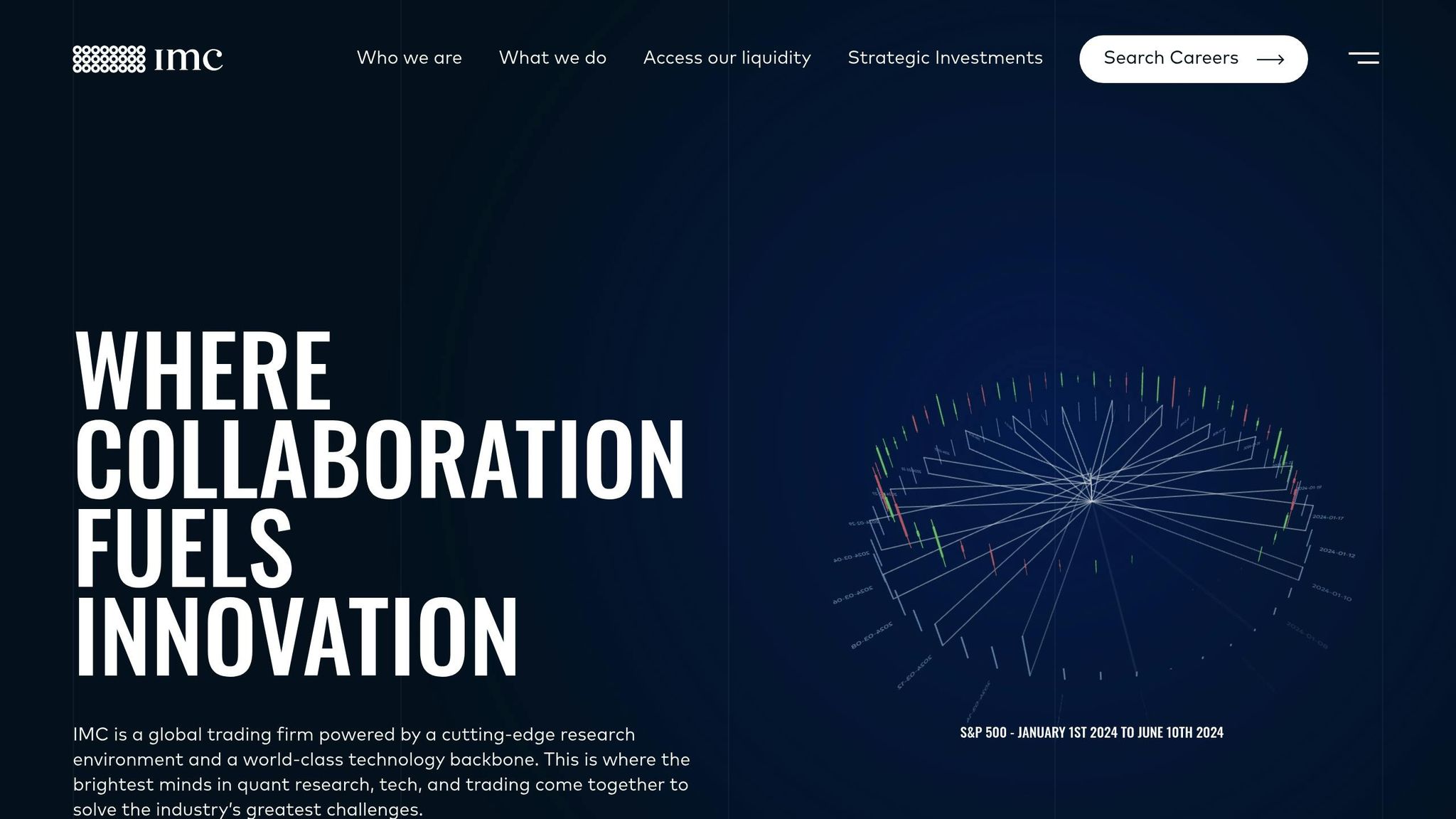
IMC Trading plays a crucial role in the fast-moving world of high-frequency trading (HFT), ensuring market liquidity across a wide range of financial instruments and regions. With operations spanning the United States, Europe, Asia-Pacific, and India, the firm connects to over 90 trading venues through its network of 9 offices, offering liquidity around the clock [12][13][14].
The firm’s trading portfolio is impressively diverse, covering asset classes such as equities, bonds, commodities, currencies, options, ETFs, and cryptocurrencies – including spot, perpetuals, futures, and options [12][13][14]. This broad approach, combined with its global presence, positions IMC Trading as a key player in providing liquidity across both traditional and modern financial markets [12][13][15]. The company’s ability to maintain such expansive market coverage and 24/7 liquidity underscores the importance of its advanced technological infrastructure, which is a cornerstone of high-frequency trading.
10. Flow Traders

Flow Traders has made a name for itself as a top-tier electronic market maker, recognized for its ability to provide liquidity globally through advanced technology and strategic positioning. Based in Amsterdam, this principal trading firm uses its own capital to facilitate trading while ensuring smoother market operations across a variety of asset classes.
At the heart of Flow Traders’ success is its expertise in electronic market making. The firm continuously quotes both buy and sell prices for a wide range of financial instruments, relying on highly advanced algorithms capable of operating simultaneously across numerous exchanges and trading platforms. While the company is best known for its focus on Exchange Traded Products (ETPs) – like ETFs, ETNs, and ETCs – it also engages in trading equities, bonds, commodities, and foreign exchange. This multi-asset, multi-venue approach not only broadens the scope of trading opportunities but also strengthens overall market liquidity.
Flow Traders operates globally, with offices strategically located in Amsterdam, New York, Hong Kong, and Singapore. This geographic reach allows the firm to offer liquidity across various time zones and adapt to different regulatory frameworks, ensuring 24/7 trading coverage.
A major factor in the firm’s competitive edge is its cutting-edge technology. Flow Traders has heavily invested in low-latency systems, advanced algorithms, and robust risk management tools, enabling it to handle thousands of transactions per second. Its proprietary technology stack includes dynamic pricing models that adjust in real time based on market conditions, inventory levels, and arbitrage opportunities. This tech-driven approach places Flow Traders among the elite in the high-frequency trading world.
Risk management is another cornerstone of the company’s operations. Flow Traders employs real-time monitoring systems to oversee positions, market exposure, and potential losses. By setting strict risk limits and employing advanced hedging techniques, the firm minimizes exposure to adverse market shifts while capitalizing on trading opportunities.
Financially, Flow Traders has shown strong performance, going public on Euronext Amsterdam in 2015. The company generates revenue primarily through bid-ask spreads and trading profits, benefiting significantly from market volatility. Its focus on ETPs has been particularly rewarding, as these products have seen rapid growth due to increasing demand from both institutional and retail investors.
Technology Requirements for HFT Operations
High-Frequency Trading (HFT) thrives on a technological foundation built for speed and dependability. Top HFT firms invest heavily in systems designed to execute trades in microseconds, showcasing how advanced infrastructure provides a competitive edge. For smaller-scale automated traders, understanding these principles can help improve their own operations.
At the core of HFT success is ultra-low latency connectivity. Leading firms rely on direct fiber connections to minimize delays, an investment that pays off by enabling them to seize fleeting market opportunities. While these dedicated connections come with high costs, the reduction in latency is critical to staying ahead in the fast-paced trading environment.
Colocation services also play a pivotal role. By housing their servers in the same data centers as exchange matching engines, firms drastically cut down the physical distance – and time – it takes for orders to reach the market. Major exchanges like the New York Stock Exchange and NASDAQ offer premium colocation options, underscoring the value of proximity in high-speed trading.
On the hardware front, HFT operations depend on custom-built servers equipped with cutting-edge AMD EPYC or Intel Xeon processors, high-speed RAM, and NVMe storage for fast data access. Some firms go a step further, incorporating specialized hardware like Field-Programmable Gate Arrays (FPGAs) and Application-Specific Integrated Circuits (ASICs) to optimize performance for specific trading tasks.
Network optimization extends beyond standard Internet setups. Dedicated engineers fine-tune data transmission to eliminate even the smallest delays. Some firms even explore alternative methods like microwave or millimeter-wave technologies to gain an edge in short-distance communications, further reducing latency.
While the scale of institutional HFT infrastructure may seem intimidating, smaller traders can adopt similar strategies on a more manageable level. For instance, high-performance VPS solutions like TraderVPS offer a way to replicate institutional-grade setups. These systems feature AMD EPYC processors, NVMe storage for rapid data handling, and robust 1Gbps+ network connections to ensure timely order execution.
Reliability is just as crucial for smaller operations as it is for institutional players. VPS solutions with redundant systems, automatic failover, and continuous monitoring ensure that trading algorithms remain operational around the clock. Adequate RAM and CPU resources are also essential, especially during volatile market conditions, to prevent performance bottlenecks.
Another advantage of modern trading infrastructure is global accessibility. Cloud-based platforms allow traders to access international markets without needing physical hardware in multiple locations, making it easier to diversify strategies and explore new opportunities.
Finally, risk management systems are a must-have. These systems monitor positions and market exposure in real time, helping traders mitigate potential risks. A reliable technological setup supports these safeguards, ensuring that automated trading strategies stay on track.
Whether for institutional or retail traders, the key principles of HFT – low latency, reliability, robust processing, and effective risk management – remain essential. By leveraging these foundations, traders can continuously refine their performance and stay competitive in the market.
Conclusion
The ten leading high-frequency trading (HFT) firms highlighted here play a central role in shaping today’s financial markets. By leveraging advanced trading systems and market-making strategies, they contribute to improved liquidity and trading efficiency.
Competition in this space is fierce, driven by a constant race to adopt cutting-edge technology. Each firm pours significant resources into upgrading infrastructure, optimizing hardware, and refining algorithms to exploit even the smallest price differences across global markets. This relentless pursuit of speed and precision keeps the industry in a state of perpetual innovation.
The growing use of artificial intelligence and machine learning is pushing HFT strategies to new levels. Advanced algorithms are being designed to analyze market behavior and execute trades with pinpoint accuracy. This trend is only expected to gain momentum, further transforming how these firms operate.
At the same time, regulatory oversight is evolving to keep pace with technological advancements. Authorities worldwide are closely examining the broader impact of concentrated HFT activity, leading to new rules that could reshape how these firms function. Adapting to these changes will require continual strategy refinement.
In addition to traditional markets, many HFT firms are branching out into areas like cryptocurrencies, foreign exchange, and commodities. These new ventures bring fresh opportunities but also present unique challenges that demand innovative solutions.
Ultimately, success in this field hinges on technological superiority – achieved through ultra-low latency, reliable infrastructure, and robust risk management. The progress of these ten firms reflects a broader shift toward tech-driven trading, with their innovations set to influence the structure, liquidity, and price discovery of financial markets for years to come.
FAQs
How do top high-frequency trading firms achieve such fast trade execution times?
High-frequency trading (HFT) firms like Citadel Securities and Virtu Financial excel at executing trades at lightning speed by relying on advanced technology and infrastructure. They pour significant resources into low-latency systems, which include high-speed computing, custom-built algorithms, and AI-powered analytics capable of processing and responding to market data in mere microseconds.
To shave off even more time, these firms often co-locate their servers directly within the data centers of major financial exchanges. This setup reduces the physical distance for data transmission, ensuring the fastest possible communication. By blending state-of-the-art technology with strategic infrastructure, they maintain their edge in the highly competitive HFT landscape.
How does advanced technology drive the success of high-frequency trading (HFT) firms, and what steps do they take to stay ahead?
High-frequency trading (HFT) firms rely heavily on advanced technology to operate at lightning speed, executing trades in mere fractions of a second. This precision enables them to take advantage of even the tiniest market inefficiencies. Their operations depend on powerful algorithms, high-speed computing systems, and low-latency data feeds to process enormous volumes of market data in real time.
To stay ahead in this highly competitive space, HFT firms consistently invest in the latest technologies. This includes advancements in analytics, machine learning, and ultra-fast networking solutions. These upgrades ensure their systems are not just fast, but also highly intelligent and efficient, keeping them well-equipped to navigate the rapid pace of global financial markets.
How do high-frequency trading firms navigate changing regulations, and what challenges do they encounter?
High-frequency trading (HFT) firms navigate a fast-changing regulatory landscape that demands both adaptability and strict compliance. They face mounting challenges, such as increased scrutiny of trading practices to curb activities like spoofing or taking unfair advantage of latency. Regulators are placing a stronger emphasis on promoting fair and transparent markets.
In response, HFT firms pour resources into cutting-edge compliance systems, including real-time monitoring tools, to keep up with these rigorous standards while staying competitive. The ongoing challenge lies in striking the right balance – pushing for innovation while ensuring their strategies support market fairness and stability.








